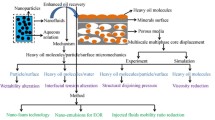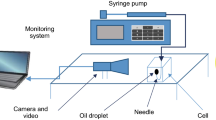Abstract
The present study aims to investigate effects of nanofluid flooding on EOR and also compares its performance with water flooding in field scale using the published experimental data provided from core-scale studies. The nanofluid is based on water including silica nanoparticles. The relative permeability curves of water, nanofluid and oil for a light crude oil core sample obtained in an experimental study are used in this numerical investigation. A 2D heterogeneous reservoir model is constructed using the permeability and porosity of the last layer of SPE-10 model. It has been shown that nanofluid flooding can substantially improve the oil recovery in comparison with the water flooding case. Afterward, the operational parameters of the 13 injection and production wells have been optimized in order to meet the maximum cumulative oil production. First, pattern search (PS) algorithm was implemented which has a good convergence speed, but with a high probability of trapping in local optimum points. Particle swarm optimization (PSO) approach has also been employed, which requires a large number of population (to approach the global optimum) with so many simulations. Accordingly, a hybrid PSO–PS algorithm with confined domain is proposed. The hybrid algorithm starts with PSO and depending on the distribution density of the values of each parameter, confines the searching domain and provides a proper initial guess to be used by PS. It is concluded that the hybrid PSO–PS method could obtain the optimal solution with a high convergence speed and reduced possibility of trapping in local optimums.
















Similar content being viewed by others
References
Negin C, Ali S, Xie Q. Application of nanotechnology for enhancing oil recovery—a review. Petroleum. 2016;2(4):324–33.
Bell AT. The impact of nanoscience on heterogeneous catalysis. Science. 2003;299(5613):1688.
Perez JM. Iron oxide nanoparticles: hidden talent. Nat Nanotechnol. 2007;2(9):535–6.
Esfe MH, Saedodin S, Bahiraei M, Toghraie D, Mahian O, Wongwises S. Thermal conductivity modeling of MgO/EG nanofluids using experimental data and artificial neural network. J Therm Anal Calorim. 2014;118(1):287–94.
Barkalina N, Charalambous C, Jones C, Coward K. Nanotechnology in reproductive medicine: emerging applications of nanomaterials. Nanomed Nanotechnol Biol Med. 2014;10(5):e921–38.
Thines RK, Mubarak NM, Nizamuddin S, Sahu JN, Abdullah EC, Ganesan P. Application potential of carbon nanomaterials in water and wastewater treatment: A review. J Taiwan Inst Chem Eng. 2017;72(Supplement C):116–33.
Socas-Rodríguez B, González-Sálamo J, Hernández-Borges J, Rodríguez-Delgado MÁ. Recent applications of nanomaterials in food safety. TrAC Trends Anal Chem. 2017;96:172–200.
Ananthakumar S, Ramkumar J, Babu SM. Semiconductor nanoparticles sensitized TiO2 nanotubes for high efficiency solar cell devices. Renew Sustain Energy Rev. 2016;57(Supplement C):1307–21.
Wang L, Zhang F. Preparation and optical properties of Sn- and Ga-doped indium oxide semiconductor nanoparticles. Ceram Int. 2017;43(13):9723–8.
Mahian O, Kianifar A, Kalogirou SA, Pop I, Wongwises S. A review of the applications of nanofluids in solar energy. Int J Heat Mass Transf. 2013;57(2):582–94.
Zhang Z, Yuan Y, Ouyang L, Sun Q, Cao X, Alelyani S. Enhanced thermal properties of Li2CO3–Na2CO3–K2CO3 nanofluids with nanoalumina for heat transfer in high-temperature CSP systems. J Therm Anal Calorim. 2017;128(3):1783–92.
Bellos E, Tzivanidis C. Thermal efficiency enhancement of nanofluid-based parabolic trough collectors. J Therm Anal Calorim. 2018. https://doi.org/10.1007/s10973-018-7056-7.
Stalin PMJ, Arjunan TV, Matheswaran MM, Sadanandam N. Experimental and theoretical investigation on the effects of lower concentration CeO2/water nanofluid in flat-plate solar collector. J Therm Anal Calorim. 2017. https://doi.org/10.1007/s10973-017-6865-4.
Rashidi S, Eskandarian M, Mahian O, Poncet S. Combination of nanofluid and inserts for heat transfer enhancement. J Therm Anal Calorim (2018). https://doi.org/10.1007/s10973-018-7070-9.
Motamedi P, Bargozin H, Pourafshary P. Management of implementation of nanotechnology in upstream oil industry: An analytic hierarchy process analysis. J Energy Resour Technol. 2017;140(5):052908.
Al-Malki N, Pourafshary P, Al-Hadrami H, Abdo J. Controlling bentonite-based drilling mud properties using sepiolite nanoparticles. Pet Explor Dev. 2016;43(4):717–23.
Shakib JT, Kanani V, Pourafshary P. Nano-clays as additives for controlling filtration properties of water–bentonite suspensions. J Pet Sci Eng. 2016;138:257–64.
Kong X, Ohadi M. Applications of micro and nano technologies in the oil and gas industry-overview of the recent progress. In: Abu Dhabi international petroleum exhibition and conference (2010).
Thomas S. Enhanced oil recovery-an overview. Oil Gas Sci Technol Rev IFP. 2008;63(1):9–19.
Rahman Arifur, Happy Fatema Akter, Ahmed Salim, Hossain M Enamul. Development of scaling criteria for enhanced oil recovery: a review. J Pet Sci Eng. 2017;158(Supplement C):66–79.
Shafiei A, Dusseault MB, Zendehboudi S, Chatzis I. A new screening tool for evaluation of steamflooding performance in Naturally Fractured Carbonate Reservoirs. Fuel. 2013;108(Supplement C):502–14.
Lv M, Wang S. Pore-scale modeling of a water/oil two-phase flow in hot water flooding for enhanced oil recovery. RSC Adv. 2015;5(104):85373–82.
Giacchetta G, Leporini M, Marchetti B. Economic and environmental analysis of a Steam Assisted Gravity Drainage (SAGD) facility for oil recovery from Canadian oil sands. Appl. Energy. 2015;142(Supplement C):1–9.
Changfeng X, Wenlong G, Jihong H. Research and application of fire-flooding technologies in post-steam injected heavy oil reservoir. In: Presented at the international petroleum technology conference (2013).
Sayyafzadeh M, Keshavarz A. Optimisation of gas mixture injection for enhanced coalbed methane recovery using a parallel genetic algorithm. J Nat Gas Sci Eng. 2016;33:942–53.
Negin C, Ali S, Xie Q. Most common surfactants employed in chemical enhanced oil recovery. Petroleum. 2017;3(2):197–211.
Lu J, et al. New surfactant developments for chemical enhanced oil recovery. J Pet Sci Eng. 2014;120(Supplement C):94–101.
Joonaki E, Erfani Gahrooei HR, Ghanaatian S. Experimental study on adsorption and wettability alteration aspects of a new chemical using for enhanced oil recovery in carbonate oil reservoirs. J Unconv Oil Gas Resour. 2016;15(Supplement C):11–21.
Ehtesabi H, Ahadian MM, Taghikhani V, Ghazanfari MH. Enhanced heavy oil recovery in sandstone cores using TiO2 nanofluids. Energy Fuels. 2014;28(1):423–30.
Ayatollahi S, Zerafat MM. Nanotechnology-assisted EOR techniques: new solutions to old challenges. In: Presented at the SPE international oilfield nanotechnology conference and exhibition (2012).
Mothé CG, Correia DZ, de França FP, Riga AT. Thermal and rheological study of polysaccharides for enhanced oil recovery. J Therm Anal Calorim. 2006;85(1):31–6.
Raffa P, Broekhuis AA, Picchioni F. Polymeric surfactants for enhanced oil recovery: A review. J Pet Sci Eng. 2016;145(Supplement C):723–33.
Moradi B, Pourafshary P, Jalali F, Mohammadi M, Emadi MA. Experimental study of water-based nanofluid alternating gas injection as a novel enhanced oil-recovery method in oil-wet carbonate reservoirs. J Nat Gas Sci Eng. 2015;27:64–73.
Hasannejad R, Pourafshary P, Vatani A, Sameni A. Application of silica nanofluid to control initiation of fines migration. Pet Explor Dev. 2017;44(5):850–9.
Bera A, Belhaj H. Application of nanotechnology by means of nanoparticles and nanodispersions in oil recovery—a comprehensive review. J Nat Gas Sci Eng. 2016;34(Supplement C):1284–309.
Alomair OA, Matar KM, Alsaeed YH. Experimental study of enhanced-heavy-oil recovery in Berea sandstone cores by use of nanofluids applications. SPE Reserv Eval Eng. 2015;18(03):387–99.
Hendraningrat L, Torsaeter O. Unlocking the potential of metal oxides nanoparticles to enhance the oil recovery. In: Presented at the offshore technology conference-Asia (2014).
Al-Farsi H, Pourafshary P, Al-Maamari RS. Application of nanoparticles to improve the performance of microwave assisted gravity drainage (MWAGD) as a thermal oil recovery method. In: Presented at the SPE EOR conference at oil and gas west Asia (2016).
Assef Y, Arab D, Pourafshary P. Application of nanofluid to control fines migration to improve the performance of low salinity water flooding and alkaline flooding. J Pet Sci Eng. 2014;124:331–40.
Parvazdavani M, Masihi M, Ghazanfari MH. Monitoring the influence of dispersed nano-particles on oil–water relative permeability hysteresis. J Pet Sci Eng. 2014;124:222–31.
Salmachi A, Sayyafzadeh M, Haghighi M. Infill well placement optimization in coal bed methane reservoirs using genetic algorithm. Fuel. 2013;111:248–58.
Sayyafzadeh M. Reducing the computation time of well placement optimisation problems using self-adaptive metamodelling. J Pet Sci Eng. 2017;151:143–58.
Azamipour V, Assareh M, Mittermeir GM. An improved optimization procedure for production and injection scheduling using a hybrid genetic algorithm. Chem Eng Res Des. 2017. https://doi.org/10.1016/j.cherd.2017.11.022.
Siavashi M, Doranehgard MH. Particle swarm optimization of thermal enhanced oil recovery from oilfields with temperature control. Appl Therm Eng. 2017;123:658–69.
Siavashi M, Garusi H, Derakhshan S. Numerical simulation and optimization of steam-assisted gravity drainage with temperature, rate, and well distance control using an efficient hybrid optimization technique. Numer Heat Transf Part Appl. 2017;72(9):721–44.
Bjørnar E. The potential of hydrophilic silica nanoparticles for EOR purposes. Master Thesis. Norwegian University of Science and Technology; 2012.
Youssif MI, El-Maghraby RM, Saleh SM, Elgibaly A. Silica nanofluid flooding for enhanced oil recovery in sandstone rocks. Egypt J Pet. 2017. https://doi.org/10.1016/j.ejpe.2017.01.006.
Wasan D, Nikolov A, Kondiparty K. The wetting and spreading of nanofluids on solids: role of the structural disjoining pressure. Curr Opin Colloid Interface Sci. 2011;16(4):344–9.
Mcelfresh PM, Holcomb DL, Ector D. Application of nanofluid technology to improve recovery in oil and gas wells. In: Presented at the SPE international oilfield nanotechnology conference and exhibition (2012).
Chengara A, Nikolov AD, Wasan DT, Trokhymchuk A, Henderson D. Spreading of nanofluids driven by the structural disjoining pressure gradient. J Colloid Interface Sci. 2004;280(1):192–201.
Dahle GS. Investigation of how hydrophilic silica nanoparticles affect oil recovery in Berea sandstone: an experimental study. Master Thesis. Norwegian University of Science and Technology; 2014.
Roustaei A, Moghadasi J, Bagherzadeh H, Shahrabadi A. An experimental investigation of polysilicon nanoparticles’ recovery efficiencies through changes in interfacial tension and wettability alteration. In: SPE international oilfield nanotechnology conference and exhibition (2012).
Li S, Hendraningrat L, Torsaeter O. Improved oil recovery by hydrophilic silica nanoparticles suspension: 2 phase flow experimental studies. In: IPTC 2013: international petroleum technology conference (2013).
Li S, Torsæter O. An experimental investigation of EOR mechanisms for nanoparticles fluid in glass micromodel. In: Presented at the paper SCA2014-022 was prepared for presentation at the international symposium of the society of core analysts held in Avignon, France, pp 8–11 (2014).
Parvazdavani M, Masihi M, Ghazanfari MH, Sherafati M, Mashayekhi L. Investigation of the effect of water based nano-particles addition on hysteresis of oil-water relative permeability curves. In: SPE international oilfield nanotechnology conference and exhibition (2012).
Marini F, Walczak B. Particle swarm optimization (PSO). A tutorial. Chemom Intell Lab Syst. 2015;149:153–65.
France van den Bergh. An analysis of particle swarm optimizers. Ph.D. Thesis, University of Pretoria (2011).
Du K-L, Swamy MNS. Search and optimization by metaheuristics. New York: Springer; 2016.
Venter G, Sobieszczanski-Sobieski J. Particle swarm optimization. AIAA J. 2003;41(8):1583–9.
Christie MA, Blunt MJ. Tenth SPE comparative solution project: a comparison of upscaling techniques. In: SPE reservoir simulation symposium (2001).
Author information
Authors and Affiliations
Corresponding author
Rights and permissions
About this article
Cite this article
Ramezanpour, M., Siavashi, M. Application of SiO2–water nanofluid to enhance oil recovery. J Therm Anal Calorim 135, 565–580 (2019). https://doi.org/10.1007/s10973-018-7156-4
Received:
Accepted:
Published:
Issue Date:
DOI: https://doi.org/10.1007/s10973-018-7156-4




